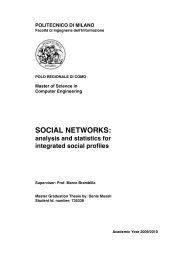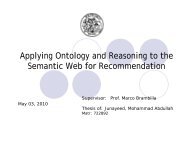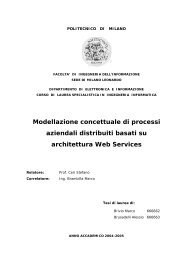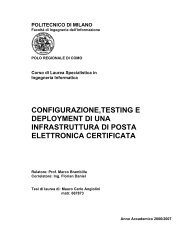Thesis full text PDF - Politecnico di Milano
Thesis full text PDF - Politecnico di Milano
Thesis full text PDF - Politecnico di Milano
You also want an ePaper? Increase the reach of your titles
YUMPU automatically turns print PDFs into web optimized ePapers that Google loves.
accompanied by a descriptor file called a Tag Library Descriptor (tld). The Struts and Struts-ELtag libraries are examples of this extended functionality. Our examples throughout the book useJSP along with Struts-EL, JSTL, and other tag libraries. For new projects, the recommendationfrom the Struts Web site is to use not the standard Struts tag libraries, but instead the Struts-ELtag library along with JSTL. The Struts-EL tags library is really a reimplementation of thestandard Struts tag library to make it compatible with JSTL’s method of evaluating values.However, when a JSTL tag implemented the same functionality, the Struts tag was notreimplemented in the Struts-EL library.The Struts ModelNothing in Struts <strong>di</strong>ctates how to construct the Model. However, the best practice is toencapsulate the business data and operations on that data into JavaBeans, as we describedpreviously when <strong>di</strong>scussing Data Transfer Objects. The data and operations may reside in thesame class or in <strong>di</strong>fferent classes, depen<strong>di</strong>ng on your application. The operations represent thebusiness logic that your application is defining. Operations may be the rules that should operateon a particular business entity. For example, if you’re writing a purchasing system, part of thebusiness data might be an entity called a Purchase Order. You may encapsulate this data into aclass called PurchaseOrder as a way of representing the Purchase Order entity. Furthermore, youmay choose to place your business rules <strong>di</strong>rectly into this class, or you may choose to put therules into a <strong>di</strong>fferent class. The connection between the Controller and Model rests in the codethat you write in the Action subclasses. The Action subclasses contain the analysis of the user’srequest that determines the interaction (if any) with the Model. The Action subclass initiates anyaction required to handle a user’s request, thereby creating the connection with the Model. Whenformulating a response, the Controller may pass some or all of the Model data to the Viewthrough the use of the ActionForm Bean. Although this Bean is a data container, it should not beconsidered part of the Model but rather just a transport mechanism between the Model and theView. Just as often, the View may <strong>di</strong>rectly reference the Model’s data by referencing one or moreof the Beans that belong to the Model. The standard MVC pattern describes an interactionbetween the Model and the View so that when the Model’s data changes, it can imme<strong>di</strong>ately pushthose changes out to the View so the user sees them. However, this is more <strong>di</strong>fficult to achievein the Web application architecture. Consequently, the View is commonly updated by the userrequesting it.The Struts configuration fileThe Struts configuration file performs an important role in structuring your Struts application.Although it is not really part of the Model, View, or Controller, it does affect the functioning of thethree layers. The configuration file allows you to define exactly which of your Action subclassesshould be used under what circumstances and which ActionForm should be given to that Actionsubclass. So you specify part of the Controller interaction in the configuration file. In ad<strong>di</strong>tion,when the Controller decides which View to return to the user, it chooses the particular Viewaccor<strong>di</strong>ng to specifications in the configuration file. Thus the configuration file actually defines36


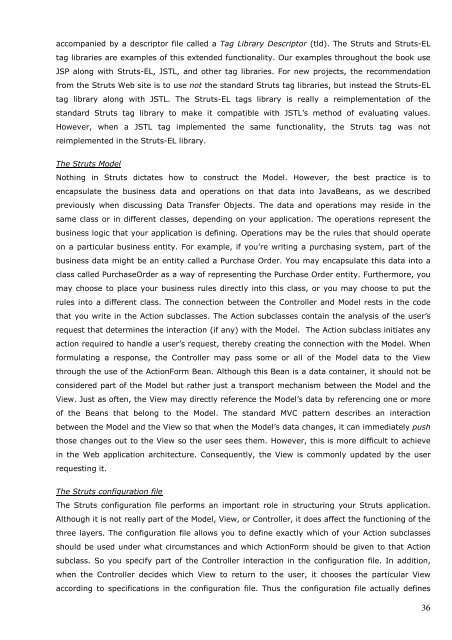
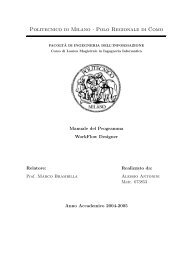
![Full text preview of the chapter [PDF] - Politecnico di Milano](https://img.yumpu.com/44021924/1/180x260/full-text-preview-of-the-chapter-pdf-politecnico-di-milano.jpg?quality=85)
